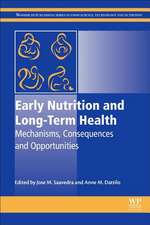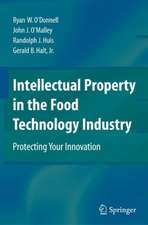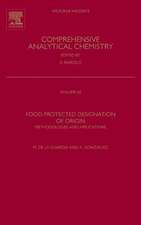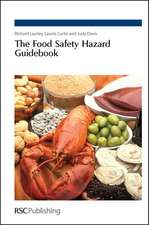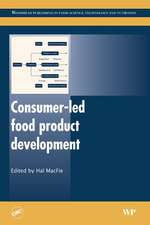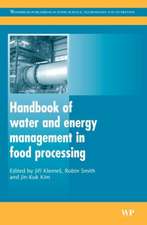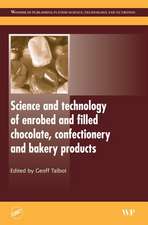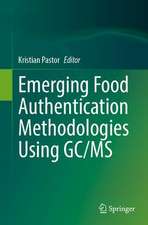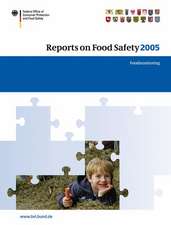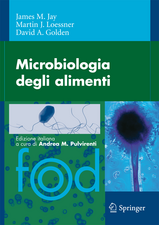Egg Innovations and Strategies for Improvements
Editat de Patricia Hesteren Limba Engleză Hardback – 5 ian 2017
Eggs are a rich source of macro- and micronutrients which are consumed not only by themselves, but also within the matrix of food products, such as pastas, cakes, and pastries. A wholesome, versatile food with a balanced array of essential nutrients, eggs are a stable of the human diet. Emerging strategies entail improvements to the composition of eggs via fortification or biological enrichment of hen's feed with polyunsaturated fatty acids, antioxidants, vitamins, or minerals. Conversely, eggs can be a source of food-borne disease or pollutants that can have effects on not only human health, but also egg production and commercial viability.
Written by an international team of experts, the book presents a unique overview of the biology and science of egg production, nutrient profiling, disease, and modes for increasing their production and quality. Designed for poultry and food scientists, technologists, microbiologists, and workers in public health and the food and egg industries, the book is valuable as an industrial reference and as a resource in academic libraries.
- Focuses on the production and food science aspects of eggs
- Includes a broad range of microbial contaminants, their risks, and prevention, as well as non-microbial contaminant risks
- Presents analytical techniques for practical application
Preț: 831.97 lei
Preț vechi: 1148.89 lei
-28% Nou
Puncte Express: 1248
Preț estimativ în valută:
159.25€ • 173.04$ • 133.85£
159.25€ • 173.04$ • 133.85£
Carte tipărită la comandă
Livrare economică 14-28 aprilie
Preluare comenzi: 021 569.72.76
Specificații
ISBN-13: 9780128008799
ISBN-10: 0128008792
Pagini: 646
Dimensiuni: 216 x 276 x 38 mm
Greutate: 1.76 kg
Editura: ELSEVIER SCIENCE
ISBN-10: 0128008792
Pagini: 646
Dimensiuni: 216 x 276 x 38 mm
Greutate: 1.76 kg
Editura: ELSEVIER SCIENCE
Public țintă
Designed for poultry and food scientists, technologists, food industry workers, microbiologists, public health workers. It is valuable as an industrial reference book and also for academic libraries that covers the domains of food production, poultry conglomerates or food science.Cuprins
Section 1: Introduction
1. Chicken Eggs
2. Quail Eggs
3. Duck Eggs
4. Guinea Fowl, Goose, Turkey, Ostrich, and Emu Eggs
Section 2: Management and Housing
5. Steroid Hormones and Female Energy Balance: Relation to Offspring Primary Sex Ratio
6. Breeder Hen Influence on Nutrient Availability for the Embryo and Hatchling
7. The Effect of Lighting and Photoperiod on Chicken Egg Production and Quality
8. Enrichments in Cages
9. Commercial Free-Range Egg Production Practices
10. Organic Farming and Mineral Content of Chicken Eggs
11. Controlling Feather Pecking and Cannibalism in Egg Laying Flocks
Section 3: Food Safety
12. Effects of Temperature and Storage Conditions on Eggs
13. The Eggshell Microbial Activity
14. Effects of Propolis on Eggshell
15. The Eggshell Proteome Yields Insight into its Antimicrobial Protection
16. Shell Egg Pasteurization
17. Effects of Gamma Radiation for Microbiological Control in Eggs
Section 4: Composition of Eggs
18. Cholesterol in Chicken Eggs: Still a Dietary Concern for Some
19. Lutein and Zeaxanthin Carotenoids in Eggs
20. Vitamins in Eggs
Section 5: Use of Eggs
21. Economic and Cultural Aspects of the Table Egg as an Edible Commodity
22. Use of Hen Egg White Lysozyme in the Food Industry
23. Function and Separation of Ovotransferrin from Chicken Egg
24. The Use of Egg and Egg Products in Pasta Production
25. The Eggshell and its Commercial and Production Importance
26. Nutraceutical Egg Products
Section 6: Improving Production
27. Use of Dietary Probiotics to Improve Laying Hen Performance
28. Improving Performance Traits of Laying Hens with Vitamin C
29. Modifying Protein in Feed
30. Improving Egg Production and Hen Health with Calcium
31. Use of Ginseng in Animal Production
32. Preventive Measures for Avoiding the Deleterious Effects of Heat Stress on Egg Production and Quality
Section 7: Improving Composition
33. Supplemental Linseed on Egg Production
34. Supplemental Flax and Impact on n3 and 6 Polyunsaturated Fatty Acids in Eggs
35. Supplemental Fish Oil and its Impact on n-3 Fatty Acids in Eggs
36. Microalgal Feed Supplementation to Enrich Eggs with Omega-3 Fatty Acids
37. Supplemental Iodine
Section 8: Preserving Eggs
38. Pickling Eggs
39. Sodium Chloride Preservation in Duck Eggs
40. Inorganic Elements in Preserved Eggs
Section 9: Adverse Non-Microbial Contaminants
41. The Effect of Estrogens on Egg-Laying Performance
42. Antimicrobial Residues in Table Eggs
43. Nitrofuran Veterinary Drug Residues in Chicken Eggs
44. Anthelmintic Benzimidazoles in Eggs
45. Flame Retardants in Wild Bird Eggs and in Relation to Eggs in the Human Food Supply
46. Polychlorinated Dibenzo-p-Dioxins, Polychlorinated Dibenzofurans, and Dioxin-Like Polychlorinated Biphenyls in Chicken Eggs
47. Influence of Plant Toxins on Laying Hen Performance and Egg Quality
Section 10: Microbial or Parasitic Contaminants
48. Salmonella and Impact on Egg Production
49. Colibacillosis and its Impact on Egg Production
50. Mycoplasmosis in Egg Laying Flocks
51. Avian Influenza Virus and Newcastle Disease Virus
52. Infectious Bronchitis
53. Coccidiosis in Egg-laying Poultry
54. Mycotoxin Impact on Egg Production
55. Parasites in Laying Hen Housing Systems
1. Chicken Eggs
2. Quail Eggs
3. Duck Eggs
4. Guinea Fowl, Goose, Turkey, Ostrich, and Emu Eggs
Section 2: Management and Housing
5. Steroid Hormones and Female Energy Balance: Relation to Offspring Primary Sex Ratio
6. Breeder Hen Influence on Nutrient Availability for the Embryo and Hatchling
7. The Effect of Lighting and Photoperiod on Chicken Egg Production and Quality
8. Enrichments in Cages
9. Commercial Free-Range Egg Production Practices
10. Organic Farming and Mineral Content of Chicken Eggs
11. Controlling Feather Pecking and Cannibalism in Egg Laying Flocks
Section 3: Food Safety
12. Effects of Temperature and Storage Conditions on Eggs
13. The Eggshell Microbial Activity
14. Effects of Propolis on Eggshell
15. The Eggshell Proteome Yields Insight into its Antimicrobial Protection
16. Shell Egg Pasteurization
17. Effects of Gamma Radiation for Microbiological Control in Eggs
Section 4: Composition of Eggs
18. Cholesterol in Chicken Eggs: Still a Dietary Concern for Some
19. Lutein and Zeaxanthin Carotenoids in Eggs
20. Vitamins in Eggs
Section 5: Use of Eggs
21. Economic and Cultural Aspects of the Table Egg as an Edible Commodity
22. Use of Hen Egg White Lysozyme in the Food Industry
23. Function and Separation of Ovotransferrin from Chicken Egg
24. The Use of Egg and Egg Products in Pasta Production
25. The Eggshell and its Commercial and Production Importance
26. Nutraceutical Egg Products
Section 6: Improving Production
27. Use of Dietary Probiotics to Improve Laying Hen Performance
28. Improving Performance Traits of Laying Hens with Vitamin C
29. Modifying Protein in Feed
30. Improving Egg Production and Hen Health with Calcium
31. Use of Ginseng in Animal Production
32. Preventive Measures for Avoiding the Deleterious Effects of Heat Stress on Egg Production and Quality
Section 7: Improving Composition
33. Supplemental Linseed on Egg Production
34. Supplemental Flax and Impact on n3 and 6 Polyunsaturated Fatty Acids in Eggs
35. Supplemental Fish Oil and its Impact on n-3 Fatty Acids in Eggs
36. Microalgal Feed Supplementation to Enrich Eggs with Omega-3 Fatty Acids
37. Supplemental Iodine
Section 8: Preserving Eggs
38. Pickling Eggs
39. Sodium Chloride Preservation in Duck Eggs
40. Inorganic Elements in Preserved Eggs
Section 9: Adverse Non-Microbial Contaminants
41. The Effect of Estrogens on Egg-Laying Performance
42. Antimicrobial Residues in Table Eggs
43. Nitrofuran Veterinary Drug Residues in Chicken Eggs
44. Anthelmintic Benzimidazoles in Eggs
45. Flame Retardants in Wild Bird Eggs and in Relation to Eggs in the Human Food Supply
46. Polychlorinated Dibenzo-p-Dioxins, Polychlorinated Dibenzofurans, and Dioxin-Like Polychlorinated Biphenyls in Chicken Eggs
47. Influence of Plant Toxins on Laying Hen Performance and Egg Quality
Section 10: Microbial or Parasitic Contaminants
48. Salmonella and Impact on Egg Production
49. Colibacillosis and its Impact on Egg Production
50. Mycoplasmosis in Egg Laying Flocks
51. Avian Influenza Virus and Newcastle Disease Virus
52. Infectious Bronchitis
53. Coccidiosis in Egg-laying Poultry
54. Mycotoxin Impact on Egg Production
55. Parasites in Laying Hen Housing Systems

